
Wine Culture and Information since 2002 - Volume 22
 Wine Culture and Information since 2002 - Volume 22 |
|
Contrasts of Trentino Marzemino and Falerno del Massico RossoTrentino and Campania compared in the glasses of this month's tasting by contrast in the expression of the Marzemino, Aglianico and Piedirosso grapes. |
|
Trentino and Campania are two decidedly different regions, not only in geographical terms but also from a viticultural and enological point of view. In the first the environment and climate are mainly high hills and mountains, in the second the panorama is mainly hilly, sloping towards the coastal areas. In Campania, as is well known, there are also territories characterized by mountains and, in many of these, viticulture has been practiced since time immemorial. The viticultural and enological vocation of Trentino and Campania evidently differs in a substantial and notable ways, especially due to the varieties of grapes that are grown in the respective vineyards. In both regions there is a rich presence of native varieties and, both in Trentino and Campania, they make a fundamental and identifying element for the wines of the respective regions. The presence of international varieties, however, is decidedly different and, in this sense, evidently distant. In Trentino, in fact, in addition to the important presence of native varieties, many of the so-called international grapes are also present in the vineyards, a decidedly common phenomenon that has now been rooted in the local wine culture for decades. In Campania, however, viticulture is mainly based on the cultivation and winemaking of native varieties, while the presence of international grapes is decidedly marginal. In this month's tasting by contrast we examine two wines from the respective regions produced with native grapes. In the case of Trentino, it is a wine produced with Marzemino – an important and celebrated red grape variety of the region – which we will compare with a red wine from Campania, in this case produced in an important denomination of the region, made of Aglianico and Piedirosso. Wines and grapes decidedly different even in wine production: monovarietal for the wine from Trentino, multivarietal for that from Campania.
|
|
Marzemino is undeniably one of the most famous and well-known grapes – and wines – of Trentino-Alto Adige. Also thanks to the famous quote by Lorenzo Da Ponte which made this wine immortal. It is a known story, in fact, that the famous librettist from Veneto, in the equally famous opera “Don Giovanni” by Wolfgang Amadeus Mozart, had the protagonist exclaim – Don Giovanni, precisely – the request addressed to the servant Leporello “Versa il vino! Eccellente Marzimino!” (“Pour the wine! Excellent Marzimino!”). It was 1787 and the wines of this grape were certainly well appreciated, most likely in Veneto, the land where Lorenzo Da Ponte was born. A proof which could strengthen the hypothesis of the origin of Marzemino in this region – Veneto – where it was certainly known before arriving in Trentino. It must be said, in fact, that the origin of Marzemino is not entirely clear, however the historical information available often places it in Veneto. According to some, in fact, the territory of Padua is considered the place of origin of this grape, while others suppose it originates from Carinthia, although a document from 1600 – found in Germany – refers to a “Marzemino of Bassano del Grappa”, in Veneto. Even the origin of the name is not entirely clear. For some it comes from the late Latin Marzarimen that is “March wheat” because of the small size of its berries. Marzemino is mainly associated with Trentino – where it is considered an indigenous variety – however it is also present in the vineyards of Veneto, Lombardy, Emilia-Romagna and Friuli-Venezia Giulia. Today it is believed that Marzemino originates from Asia Minor, introduced in 1600 in Veneto thanks to the commercial activities of the Republic of Venice, then in Trentino. In this region, Marzemino is mainly cultivated in the southern areas of Trentino, particularly in Vallagarina, Isera and Ziresi, near Rovereto. In accordance with the Trentino DOC production disciplinary, Marzemino is also produced in the superior and reserve styles.
|
||||
|
Whenever the wines of this important denomination of origin of Campania – in the province of Caserta – are mentioned, the association with those of ancient Rome is almost inevitable. In fact, the most famous and celebrated wine in ancient Roman times came from these lands, sought after and appreciated so much that it became legendary: Falernum. This territory was famous in those times as Ager Falernus, an unmistakable sign of the very high vocation and fertility of its lands, not only for the cultivation of vines and the production of wine. The origin of Falernum is lost in the mists of time, among legends and myths, including the benevolence of the Roman god Bacchus who transformed the slopes of Mount Massico into flourishing and prodigious vineyards capable of producing the famous and legendary wine. What is certain, however, is that viticulture has been practiced in these lands since time immemorial. It is believed that the cultivation of vines in this territory was started by the Greek-Mycenaean colonizers, subsequently developed by the Etruscans, and finally by the ancient Romans. Today Falerno del Massico is a territory recognized as a Denominazione d'Origine Controllata (Controlled Denomination of Origin, DOC) and its disciplinary provides for the production of red, white and monovarietal wines from Primitivo grapes. The white style is mainly produced with Falanghina, while the red – which we examine in our tasting – is made from the blend of the Aglianico and Piedirosso grapes, known in Campania as pere 'e palummo, that is `pigeon's foot” because of red color of the rachis and peduncle. Falerno del Massico Rosso – which can also be produced as reserve style – is made with Aglianico for a minimum of 60% and Piedirosso for a maximum of 40%. Any remaining part may be made up of red grape varieties allowed in Campania region. In this regard, it should be noted that the majority of Falerno del Massico Rosso is produced exclusively with Aglianico and Piedirosso.
|
The availability of the two wines that we will evaluate in this month's tasting by contrast is relatively common, as their production level is quite good in their respective territories. In fact, it is not unlikely to see them on the shelves of large-scale retail shops – in particular, Trentino Marzemino – and certainly easy to find in any well-stocked wine shop. Speaking of the winemaking technique, it must be said that, in general terms, Trentino Marzemino is frequently aged in inert containers, while Falerno del Massico Rosso is usually aged in cask, including barrique. We will therefore have to consider this important enological factor when evaluating the two wines, trying to filter as much as possible the sensations attributable to the aging in wood. As regards the composition, in consideration of the respective production specifications, we will choose a Trentino Marzemino exclusively produced with this variety, while for Falerno del Massico Rosso we will opt for a bottle produced with Aglianico and Piedirosso. The two wines are served in tasting glasses at a temperature of 18 °C. (65 °F) Let's pour Trentino Superiore and Falerno del Massico Rosso into their respective glasses and begin this month's tasting by contrast. The first wine of which we examine appearance is Marzemino. We tilt the glass over a white surface – a sheet of paper is enough – and observe the base. The color of Trentino wine is intense ruby red, often deep, while observing its edge, towards the opening of the glass, we can clearly see a purple red color. The transparency of Trentino Marzemino – evaluated by placing a contrasting object between the glass and the white surface – is decidedly reduced. Let's now pass to the evaluation of the appearance of Falerno del Massico Rosso and, by holding the glass tilted over the white surface, let's observe the base. Also in this case there is an intense and brilliant ruby red color, while the nuance – observed towards the opening of the glass – reveals a ruby red hue. The transparency of the wine from Campania, despite being low, is generally higher than that of Marzemino. The aromas of Trentino Marzemino and Falerno del Massico Rosso are characterized by substantial differences and, in this specific case, also by the enological practices with which they are produced. Furthermore, the olfactory profile of the first wine is the result of a single variety, while that of the second is produced by the union of Aglianico and Piedirosso. Trentino Marzemino can be mainly recognized for its intense olfactory profile of dark and red pulp fruits, in particular, black cherry, plum, raspberry and blackberry. The world of flowers is mainly represented by violets, cyclamen and geranium. Moreover, a characteristic frequently perceived in the glasses of Trentino Marzemino is the pleasing scent of almond. The olfactory profile of Falerno del Massico Rosso is also strongly characterized by aromas of dark pulp fruits, in particular blackberry, plum, blueberry and black cherry. The sensations recalling the world of flowers and perceptible in this wine from Campania are mainly reminiscent of violet and rose. Let's continue this month's tasting by contrast and proceed with the evaluation of the olfactory profiles of the two wines, starting – as in the previous phase – from the Trentino Marzemino. Let's hold the glass in vertical position and, without swirling, do the first smell in order to evaluate the opening of the wine, that is, the identification of its primary aromas. From the glass are perceived intense, clean and pleasing aromas of black cherry, plum and raspberry followed by the unmistakable scent of violet. After having swirled the glass, the olfactory profile of Trentino Marzemino is completed with the aromas of blackberry, blueberry, cyclamen and geranium, in addition to the characteristic and pleasing aroma of almond. Let's now move on to the evaluation of the olfactory profile of Falerno del Massico Rosso and proceed with the evaluation of its opening. From the glass we can appreciate the intense and pleasing aromas of blackberry, plum and blueberry as well as that of violet. After having swirled the glass and did the second smell, the olfactory profile is completed with black cherry, blueberry and a touch of rose. In the profile of Falerno del Massico Rosso, also note the contribution of wood, which is totally absent in Trentino Marzemino. Let's now move on to the evaluation of the gustatory profiles of the two wines of this month's tasting by contrast, starting from the evaluation of the attack, that is, the primary and identifying gustatory sensations of the wines perceived in the mouth. The attack of Trentino Marzemino is of moderate astringency – not excessive, but definitely suited to the style of the wine – as well as a pleasing crispness given by the acidity. These two stimuli find a perfect balance with the effect of alcohol. In the mouth we also perceive a good structure and the flavors of black cherry, plum and raspberry are clearly distinguishable. Let's now move on to the evaluation of the attack of the Falerno del Massico Rosso and, after having taken the first sip, in the mouth we can perceive a moderate astringency – generally more intense than the Trentino wine – and a greater roundness given by the alcohol and the aging in wood. Furthermore, in the mouth we can perceive the flavors of plum, blackberry and blueberry, therefore expressing a good correspondence with the nose. After having swallowed the two wines, we proceed with the analysis of the final sensations they leave in the mouth, in particular the taste-olfactory persistence, the primary quality factor. The finish of Trentino Marzemino is persistent and in the mouth we can clearly perceive both the moderate astringency and the pleasing crispness, as well as the sensation of good structure. Furthermore, in the mouth we can continue to perceive the flavors of black cherry, plum, raspberry and blueberry as well as the characteristic and slight bitter hint in which we recognize almond. The finish of Falerno del Massico Rosso is equally persistent and, also in this case, in the mouth we continue to perceive the sensation of moderate astringency in addition to the pleasing roundness given by the aging in wood. Finally, we can also perceive a pleasing hint of crispness given by the acidity, a quality mainly determined by Aglianico. In the mouth we also continue to perceive the intense and pleasing flavors of plum, black cherry, blackberry and blueberry.
|
||||||||
Wines of the Month |
|
|
|
Score legend Prices are to be considered as indicative. Prices may vary according to the country or the shop where wines are bought |
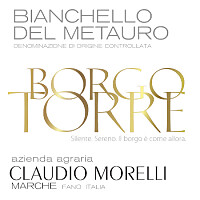
|
|
Bianchello del Metauro Superiore Borgo Torre 2022 |
|
| Claudio Morelli (Marches, Italy) | |
 Biancame Biancame | |
| Price: € 14.00 | Score: |
 Intense straw yellow and nuances of straw yellow, very transparent. Intense straw yellow and nuances of straw yellow, very transparent. Intense, clean, pleasing, refined and elegant, starts with hints of
apple, pear and plum followed by aromas of hawthorn, broom, linden, medlar,
kiwi, peach, citrus fruits, pineapple, almond and marjoram. Intense, clean, pleasing, refined and elegant, starts with hints of
apple, pear and plum followed by aromas of hawthorn, broom, linden, medlar,
kiwi, peach, citrus fruits, pineapple, almond and marjoram.
 Crisp attack and however balanced by alcohol, good body, intense
flavors, agreeable. Crisp attack and however balanced by alcohol, good body, intense
flavors, agreeable.
 Persistent finish with flavors of apple, pear and plum. Persistent finish with flavors of apple, pear and plum. Aged in steel tanks. Aged in steel tanks. |
|
 Pasta with fish, Fried fish, Sauteed fish, Sauteed white meat, Dairy products Pasta with fish, Fried fish, Sauteed fish, Sauteed white meat, Dairy products |
|
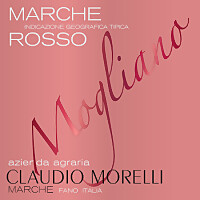
|
|
Mogliano 2017 |
|
| Claudio Morelli (Marches, Italy) | |
 n.d. n.d. | |
| Price: € 18.00 | Score: |
 Deep ruby red and nuances of garnet red, little transparency. Deep ruby red and nuances of garnet red, little transparency. Intense, clean, pleasing, refined and elegant, starts with hints of
black cherry, blueberry and blackberry followed by aromas of dried violet,
peony, plum, raspberry, cocoa, carob, tobacco, mace, leather, black pepper,
vanilla and menthol. Intense, clean, pleasing, refined and elegant, starts with hints of
black cherry, blueberry and blackberry followed by aromas of dried violet,
peony, plum, raspberry, cocoa, carob, tobacco, mace, leather, black pepper,
vanilla and menthol.
 Properly tannic attack and however balanced by alcohol, full body,
intense flavors, pleasing roundness. Properly tannic attack and however balanced by alcohol, full body,
intense flavors, pleasing roundness.
 Persistent finish with flavors of black cherry, blueberry and
blackberry. Persistent finish with flavors of black cherry, blueberry and
blackberry.
 15 months in barrique, 8 months in bottle. 15 months in barrique, 8 months in bottle. |
|
 Game, Roasted meat, Stewed and braised meat with mushrooms, Hard cheese Game, Roasted meat, Stewed and braised meat with mushrooms, Hard cheese |
|
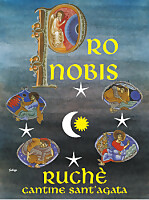
|
|
Ruchè di Castagnole Monferrato Riserva Pro Nobis 2020 |
|
| Sant'Agata (Piedmont, Italy) | |
 Ruchè Ruchè | |
| Price: € 18.00 | Score: |
 Intense ruby red and nuances of garnet red, little transparency. Intense ruby red and nuances of garnet red, little transparency. Intense, clean, pleasing and refined, starts with hints of black
cherry, strawberry and plum followed by aroma of dried violet, dried rose,
raspberry, blueberry, tobacco, mace, vanilla and menthol. Intense, clean, pleasing and refined, starts with hints of black
cherry, strawberry and plum followed by aroma of dried violet, dried rose,
raspberry, blueberry, tobacco, mace, vanilla and menthol.
 Properly tannic attack and however balanced by alcohol, good body,
intense flavors, agreeable. Properly tannic attack and however balanced by alcohol, good body,
intense flavors, agreeable.
 Persistent finish with flavors of black cherry, strawberry and plum. Persistent finish with flavors of black cherry, strawberry and plum. At least 12 months in cask. At least 12 months in cask. |
|
 Roasted meat, Stewed meat with mushrooms, Broiled meat and barbecue Roasted meat, Stewed meat with mushrooms, Broiled meat and barbecue |
|

|
|
Ruchè di Castagnole Monferrato Riserva Genesi 2018 |
|
| Sant'Agata (Piedmont, Italy) | |
 Ruchè Ruchè | |
| Price: € 35.00 | Score: |
 Intense ruby red and nuances of garnet red, little transparency. Intense ruby red and nuances of garnet red, little transparency. Intense, clean, pleasing, refined and elegant, starts with hints of
plum, strawberry and dried violet followed by aromas of dried rose, black
cherry, raspberry, blueberry, cocoa, tobacco, leather, licorice, black
pepper, vanilla and menthol. Intense, clean, pleasing, refined and elegant, starts with hints of
plum, strawberry and dried violet followed by aromas of dried rose, black
cherry, raspberry, blueberry, cocoa, tobacco, leather, licorice, black
pepper, vanilla and menthol.
 Properly tannic attack and however balanced by alcohol, good body,
intense flavors, agreeable. Properly tannic attack and however balanced by alcohol, good body,
intense flavors, agreeable.
 Persistent finish with flavors of plum, strawberry and black cherry. Persistent finish with flavors of plum, strawberry and black cherry. 30 months in barrique, at least 6 months in bottle. 30 months in barrique, at least 6 months in bottle. |
|
 Roasted meat, Stewed meat with mushrooms, Broiled meat and barbecue, Hard cheese Roasted meat, Stewed meat with mushrooms, Broiled meat and barbecue, Hard cheese |
|
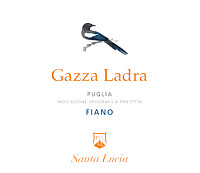
|
|
Gazza Ladra 2022 |
|
| Santa Lucia (Apulia, Italy) | |
 Fiano Fiano | |
| Price: € 19.00 | Score: |
 Brilliant straw yellow and nuances of greenish yellow, very
transparent. Brilliant straw yellow and nuances of greenish yellow, very
transparent.
 Intense, clean, pleasing, refined and elegant, starts with hints of
apple, pear and peach followed by aromas of hawthorn, jasmine, broom,
pineapple, peach, plum, melon, medlar, grapefruit and citron. Intense, clean, pleasing, refined and elegant, starts with hints of
apple, pear and peach followed by aromas of hawthorn, jasmine, broom,
pineapple, peach, plum, melon, medlar, grapefruit and citron.
 Crisp attack and however balanced by alcohol, good body, intense
flavors, agreeable. Crisp attack and however balanced by alcohol, good body, intense
flavors, agreeable.
 Persistent finish with flavors of apple, peach and peach. Persistent finish with flavors of apple, peach and peach. 6 months in vitrified tanks. 6 months in vitrified tanks. |
|
 Pasta with crustaceans and fish, Stewed crustaceans, Sauteed fish, Sauteed white meat, Mushroom soups, Dairy products Pasta with crustaceans and fish, Stewed crustaceans, Sauteed fish, Sauteed white meat, Mushroom soups, Dairy products |
|

|
|
Castel del Monte Nero di Troia Riserva Le More 2019 |
|
| Santa Lucia (Apulia, Italy) | |
 Uva di Troia Uva di Troia | |
| Price: € 30.00 | Score: |
 Intense ruby red and nuances of garnet red, little transparency. Intense ruby red and nuances of garnet red, little transparency. Intense, clean, pleasing, refined and elegant, starts with hints of
black cherry, plum and blackberry followed by aromas of dried violet, black
currant, blueberry, raspberry, cocoa, tobacco, cinnamon, mace, licorice,
leather, vanilla and menthol. Intense, clean, pleasing, refined and elegant, starts with hints of
black cherry, plum and blackberry followed by aromas of dried violet, black
currant, blueberry, raspberry, cocoa, tobacco, cinnamon, mace, licorice,
leather, vanilla and menthol.
 Properly tannic attack and however balanced by alcohol, full body,
intense flavors, pleasing roundness. Properly tannic attack and however balanced by alcohol, full body,
intense flavors, pleasing roundness.
 Very persistent finish with long flavors of black cherry, plum and
blackberry. Very persistent finish with long flavors of black cherry, plum and
blackberry.
 18 months in barrique, 12 months in bottle. 18 months in barrique, 12 months in bottle. |
|
 Game, Roasted meat, Stewed and braised meat with mushrooms, Hard cheese Game, Roasted meat, Stewed and braised meat with mushrooms, Hard cheese |
|
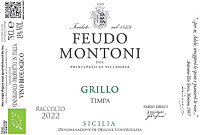
|
|
Sicilia Grillo Timpa 2022 |
|
| Feudo Montoni (Sicily, Italy) | |
 Grillo Grillo | |
| Price: € 13.50 | Score: |
 Intense greenish yellow and nuances of greenish yellow, very
transparent. Intense greenish yellow and nuances of greenish yellow, very
transparent.
 Intense, clean, pleasing, refined and elegant, starts with hints of
apple, pear and peach followed by aromas of broom, hawthorn, jasmine, elder
flower, plum, pineapple, citron, medlar, almond and mineral. Intense, clean, pleasing, refined and elegant, starts with hints of
apple, pear and peach followed by aromas of broom, hawthorn, jasmine, elder
flower, plum, pineapple, citron, medlar, almond and mineral.
 Crisp attack and however balanced by alcohol, good body, intense
flavors, agreeable. Crisp attack and however balanced by alcohol, good body, intense
flavors, agreeable.
 Persistent finish with flavors of apple, pear and peach. Persistent finish with flavors of apple, pear and peach. 6 months in cement tanks. 6 months in cement tanks. |
|
 Pasta with fish, Stewed crustaceans, Sauteed fish, Sauteed white meat, Dairy products Pasta with fish, Stewed crustaceans, Sauteed fish, Sauteed white meat, Dairy products |
|
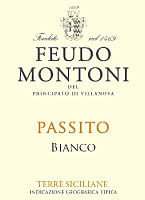
|
|
Passito Bianco |
|
| Feudo Montoni (Sicily, Italy) | |
 Grillo, Catarratto Grillo, Catarratto | |
| Price: € 30.00 - 375ml | Score: |
 Brilliant amber yellow and nuances of amber yellow, transparent. Brilliant amber yellow and nuances of amber yellow, transparent. Intense, clean, pleasing, refined and elegant, starts with hints of
raisin, dried apricot and date followed by aromas of lavender, quince jam,
peach jam, candied fruits, dried fig, honey, citrus peel, almond, sage and
vanilla. Intense, clean, pleasing, refined and elegant, starts with hints of
raisin, dried apricot and date followed by aromas of lavender, quince jam,
peach jam, candied fruits, dried fig, honey, citrus peel, almond, sage and
vanilla.
 Sweet and round attack, however balanced by alcohol, good body, intense
flavors, pleasing crispness. Sweet and round attack, however balanced by alcohol, good body, intense
flavors, pleasing crispness.
 Persistent finish with flavors of raisin, dried apricot and date. Persistent finish with flavors of raisin, dried apricot and date. 7 months in cask, 12 months in bottle. 7 months in cask, 12 months in bottle. |
|
 Dried fruit tarts, Confectionery, Hard and piquant cheese Dried fruit tarts, Confectionery, Hard and piquant cheese |
|

|
|
Cannonau di Sardegna Classico Nepente di Oliena Carros 2019 |
|
| Puddu (Sardinia, Italy) | |
 Cannonau Cannonau | |
| Price: € 15.00 | Score: |
 Brilliant ruby red and nuances of garnet red, moderate transparency. Brilliant ruby red and nuances of garnet red, moderate transparency. Intense, clean, pleasing and refined, starts with hints of black
cherry, plum and blueberry followed by aromas of violet, raspberry, carob,
cocoa, tobacco, thyme, vanilla and menthol. Intense, clean, pleasing and refined, starts with hints of black
cherry, plum and blueberry followed by aromas of violet, raspberry, carob,
cocoa, tobacco, thyme, vanilla and menthol.
 Properly tannic attack and however balanced by alcohol, good body,
intense flavors, agreeable. Properly tannic attack and however balanced by alcohol, good body,
intense flavors, agreeable.
 Persistent finish with flavors of black cherry, plum and blueberry. Persistent finish with flavors of black cherry, plum and blueberry. 12 months in cask, 3 months in bottle. 12 months in cask, 3 months in bottle. |
|
 Stuffed pasta with meat and mushrooms, Broiled meat and barbecue, Roasted meat, Stewed meat with mushrooms Stuffed pasta with meat and mushrooms, Broiled meat and barbecue, Roasted meat, Stewed meat with mushrooms |
|

|
|
Cannonau di Sardegna Riserva Nepente di Oliena Pro Vois 2019 |
|
| Puddu (Sardinia, Italy) | |
 Cannonau Cannonau | |
| Price: € 33.00 | Score: |
 Intense ruby red and nuances of garnet red, little transparency. Intense ruby red and nuances of garnet red, little transparency. Intense, clean, pleasing, refined and elegant, starts with hints of
black cherry, plum and blueberry followed by aromas of dried violet, dried
rose, raspberry, blackberry, carob, cocoa, tobacco, leather, mace, licorice
and vanilla. Intense, clean, pleasing, refined and elegant, starts with hints of
black cherry, plum and blueberry followed by aromas of dried violet, dried
rose, raspberry, blackberry, carob, cocoa, tobacco, leather, mace, licorice
and vanilla.
 Properly tannic attack and however balanced by alcohol, full body,
intense flavors, pleasing roundness. Properly tannic attack and however balanced by alcohol, full body,
intense flavors, pleasing roundness.
 Persistent finish with flavors of black cherry, plum and blueberry. Persistent finish with flavors of black cherry, plum and blueberry. 12 months in barrique, 6 months in bottle. 12 months in barrique, 6 months in bottle. |
|
 Game, Roasted meat, Stewed and braised meat with mushrooms, Hard cheese Game, Roasted meat, Stewed and braised meat with mushrooms, Hard cheese |
|
|
||||||||
|
DiWineTaste Polls
|
| |||||||
Privacy Policy | |||||||


| Copyright © 2002-2024 Antonello Biancalana, DiWineTaste - All rights reserved |
| All rights reserved under international copyright conventions. No part of this publication and of this WEB site may be
reproduced or utilized in any form or by any means, electronic or mechanical, without permission in writing from DiWineTaste. |